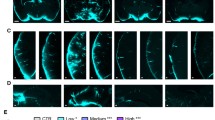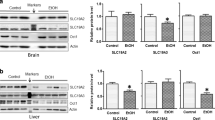Abstract
Chronic alcohol (ethanol) abuse causes neuroinflammation and brain damage that can give rise to alcoholic dementia. Insightfully, Dr. Albert Sun was an early proponent of oxidative stress as a key factor in alcoholism-related brain deterioration. In fact, oxidative stress has proven to be critical to the hippocampal and temporal cortical neurodamage resulting from repetitive “binge” alcohol exposure in adult rat models. Although the underlying mechanisms are uncertain, our immunoelectrophoretic and related assays in binge alcohol experiments in vivo (adult male rats) and in vitro (rat organotypic hippocampal-entorhinal cortical slice cultures) have implicated phospholipase A2 (PLA2)-activated neuroinflammatory pathways, release of pro-oxidative arachidonic acid (20:4 ω6), and elevated oxidative stress adducts (i.e., 4-hydroxynonenal-protein adducts). Also, significantly increased by the binge alcohol treatments was aquaporin-4 (AQP4), a water channel enriched in astrocytes that, when augmented, may trigger brain (esp. cellular) edema and neuroinflammation; of relevance, glial swelling is known to provoke increased PLA2 activities or levels. Concomitant with PLA2 activation, the results have further implicated binge alcohol-elevated poly (ADP-ribose) polymerase-1 (PARP-1), an oxidative stress-responsive DNA repair enzyme linked to parthanatos, a necrotic-like neuronal death process. Importantly, supplementation of the brain slice cultures with docosahexaenoic acid (22:6 ω3) exerted potent suppression of the induced changes in PLA2 isoforms, AQP4, PARP-1 and oxidative stress footprints, and prevention of the binge alcohol neurotoxicity, by as yet unknown mechanisms. These neuroinflammatory findings from our binge alcohol studies and supportive rat binge studies in the literature are reviewed.

Similar content being viewed by others
Abbreviations
- AQP4:
-
Aquaporin-4
- ARA:
-
Arachidonic acid
- ATZ:
-
Acetazolamide
- DHA:
-
Docosahexaenoic acid
- PARP-1:
-
Poly (ADP-ribose) polymerase-1
- PLA2 :
-
Phospholipase A2
- ROS:
-
Reactive oxygen species
References
Collins MA, Neafsey EJ (2012) Ethanol and adult CNS neurodamage: oxidative stress, but possibly not excitotoxicity. Front Biosci 4:1358–1367
Sun GY, Rudeen PK, Wood WG, Wei YH, Sun AY (1989) Molecular mechanisms of alcohol: neurobiology and metabolism. Humana, Clifton, p 397
Sun AY, Ingelman-Sundberg M, Neve E, Matsumoto H, Nishitani Y, Minowa Y, Fukui Y, Bailey SM, Patel VB, Cunningham CC, Zima T, Fialova L, Mikulikova L, Popov P, Malbohan I, Janebova M, Nespor K, Sun GY (2001) Ethanol and oxidative stress. Alcohol Clin Exp Res 25:237S–243S
Corso TD, Mostafa HM, Collins MA, Neafsey EJ (1998) Brain neuronal degeneration caused by episodic alcohol intoxication in rats: effects of nimodipine, 6,7-dinitro-quinoxaline-2,3-dione, and MK-801. Alcohol Clin Exp Res 22:217–224
Collins MA, Zou JY, Neafsey EJ (1998) Brain damage due to episodic alcohol exposure in vivo and in vitro: furosemide neuroprotection implicates edema-based mechanism. Faseb J 12:221–230
Hamelink C, Hampson A, Wink DA, Eiden LE, Eskay RL (2005) Comparison of cannabidiol, antioxidants, and diuretics in reversing binge ethanol-induced neurotoxicity. J Pharmacol Exp Ther 314:780–788
Majchrowicz E (1975) Induction of physical dependence upon ethanol and the associated behavioral changes in rats. Psychopharmacologia 43:245–254
Snyder H, Williams D, Zink B, Reilly K (1992) Accuracy of blood ethanol determination using serum osmolality. J Emerg Med 10:129–133
Adachi J, Mizoi Y, Fukunaga T, Ogawa Y, Ueno Y, Imamichi H (1991) Degrees of alcohol intoxication in 117 hospitalized cases. J Stud Alcohol 52:448–453
David KK, Andrabi SA, Dawson TM, Dawson VL (2009) Parthanatos, a messenger of death. Front Biosci 14:1116–1128
Aschner M, Allen JW, Mutkus LA, Cao C (2001) Ethanol-induced swelling in neonatal rat primary astrocyte cultures. Brain Res 900:219–226
Sripathirathan K, Brown J, Neafsey EJ, Collins MA (2009) Linking binge alcohol-induced neurodamage to brain edema and potential aquaporin-4 upregulation: evidence in rat organotypic brain slice cultures and in vivo. J Neurotrauma 26:261–273
Huber VJ, Tsujita M, Yamazaki M, Sakimura K, Nakada T (2007) Identification of arylsulfonamides as Aquaporin 4 inhibitors. Bioorg Med Chem Lett 17:1270–1273
Tanimura Y, Hiroaki Y, Fujiyoshi Y (2009) Acetazolamide reversibly inhibits water conduction by aquaporin-4. J Struct Biol 166:16–21
Fukuda AM, Badaut J (2012) Aquaporin 4: a player in cerebral edema and neuroinflammation. J Neuroinflammation 9:279
Katada R, Nishitani Y, Honmou O, Mizuo K, Okazaki S, Tateda K, Watanabe S, Matsumoto H (2012) Expression of aquaporin-4 augments cytotoxic brain edema after traumatic brain injury during acute ethanol exposure. Am J Pathol 180:17–23
Li L, Zhang H, Varrin-Doyer M, Zamvil SS, Verkman AS (2011) Proinflammatory role of aquaporin-4 in autoimmune neuroinflammation. FASEB J 25:1556–1566
Sun GY, Shelat PB, Jensen MB, He Y, Sun AY, Simonyi A (2010) Phospholipases A2 and inflammatory responses in the central nervous system. NeuroMolecular Med 12:133–148
Adibhatla RM, Hatcher JF (2008) Phospholipase A (2), reactive oxygen species, and lipid peroxidation in CNS pathologies. BMB Rep 41:560–567
Yagami T, Yamamoto Y, Koma H (2013) The role of secretory phospholipase A2 in the central nervous system and neurological diseases. Mol Neurobiol 1–14
Moses GS, Jensen MD, Lue LF, Walker DG, Sun AY, Simonyi A, Sun GY (2006) Secretory PLA2-IIA: a new inflammatory factor for Alzheimer’s disease. J Neuroinflammation 3
Green JT, Orr SK, Bazinet RP (2008) The emerging role of group VI calcium-independent phospholipase A2 in releasing docosahexaenoic acid from brain phospholipids. J Lipid Res 49:939–944
Allyson J, Bi X, Baudry M, Massicotte G (2012) Maintenance of synaptic stability requires calcium-independent phospholipase A 2 activity. Neural Plast 2012
Tajuddin N, Przybycien-Szymanska MM, Mitchell RM, Pak TR, Neafsey EJ, Collins MA (2012) Adult rats subjected to repetitive binge-pattern ethanol exposure show evidence of neuroinflammation involving elevated aquaporin-4, PLA2 and PARP-1. Alcohol Clin Exp Res 36:35A
Tajuddin N, Przybycien-Szymanska MM, Pak TR, Neafsey EJ, Collins MA (2013) Effect of repetitive daily ethanol intoxication on adult rat brain: significant changes in phospholipase A2 enzyme levels in association with increased PARP-1 indicate neuroinflammatory pathway activation. Alcohol 47:39–45
Chiu LY, Ho FM, Shiah SG, Chang Y, Lin WW (2011) Oxidative stress initiates DNA damager MNNG-induced poly (ADP-ribose) polymerase-1-dependent parthanatos cell death. Biochem Pharmacol 81:459–470
Collins MA, Corso TD, Neafsey EJ (1996) Neuronal degeneration in rat cerebrocortical and olfactory regions during subchronic “binge” intoxication with ethanol: possible explanation for olfactory deficits in alcoholics. Alcohol Clin Exp Res 20:284–292
Brown J 3rd, Achille N, Neafsey EJ, Collins MA (2009) Binge ethanol-induced neurodegeneration in rat organotypic brain slice cultures: effects of PLA2 inhibitor mepacrine and docosahexaenoic acid (DHA). Neurochem Res 34:260–267
Collins MA, Moon KH, Tajuddin N, Neafsey EJ, Kim HY (2013) Docosahexaenoic acid (DHA) prevents binge ethanol-dependent aquaporin-4 elevations while inhibiting neurodegeneration: experiments in rat adult-age entorhino-hippocampal slice cultures. Neurotoxicity Res 23:105–110
Bazan NG, Molina MF, Gordon WC (2011) Docosahexaenoic Acid signalolipidomics in nutrition: significance in aging, neuroinflammation, macular degeneration, Alzheimer’s, and other neurodegenerative diseases. Annu Rev Nutr 31:321–351
Wang J, Du H, Jiang L, Ma X, de Graaf RA, Behar KL, Mason GF (2013) Oxidation of ethanol in the rat brain and effects associated with chronic ethanol exposure. Proc Natl Acad Sci 110:14444–14449
Heit C, Dong H, Chen Y, Thompson DC, Deitrich RA, Vasiliou VK (2013) The role of CYP2E1 in alcohol metabolism and sensitivity in the central nervous system. Subcell Biochem 67:235–247
Alikunju S, Abdul Muneer PM, Zhang Y, Szlachetka AM, Haorah J (2011) The inflammatory footprints of alcohol-induced oxidative damage in neurovascular components. Brain Behav Immun 25:S129–S136
Knapp DJ, Crews FT (1999) Induction of cyclooxygenase-2 in brain during acute and chronic ethanol treatment and ethanol withdrawal. Alcohol Clin Exp Res 23:633–643
Crews F, Nixon K, Kim D, Joseph J, Shukitt-Hale B, Qin L, Zou J (2006) BHT blocks NF-kappaB activation and ethanol-induced brain damage. Alcohol Clin Exp Res 30:1938–1949
Cippitelli A, Damadzic R, Frankola K, Goldstein A, Thorsell A, Singley E, Eskay RL, Heilig M (2010) Alcohol-induced neurodegeneration, suppression of transforming growth factor-beta, and cognitive impairment in rats: prevention by group II metabotropic glutamate receptor activation. Biol Psychiatry 67:823–830
Ryu KY, Cho GS, Piao HZ, Kim WK (2012) Role of TGF-beta in survival of phagocytizing microglia: autocrine suppression of TNF-alpha production and oxidative stress. Exp Neurobiol 21:151–157
Ashley DM, Sampson JH, Archer GE, Hale LP, Bigner DD (1998) Local production of TGF beta1 inhibits cerebral edema, enhances TNF-alpha induced apoptosis and improves survival in a murine glioma model. J Neuroimmunol 86:46–52
Pushpakiran G, Mahalakshmi K, Anuradha CV (2004) Taurine restores ethanol-induced depletion of antioxidants and attenuates oxidative stress in rat tissues. Amino Acids 27:91–96
Baydas G, Tuzcu M (2005) Protective effects of melatonin against ethanol-induced reactive gliosis in hippocampus and cortex of young and aged rats. Exp Neurol 194:175–181
Amanvermez R, Agara E (2006) Does ascorbate/L-Cys/L-Met mixture protect different parts of the rat brain against chronic alcohol toxicity? Adv Ther 23:705–718
Kasdallah-Grissa A, Mornagui B, Aouani E, Hammami M, Gharbi N, Kamoun A, El-Fazaa S (2006) Protective effect of resveratrol on ethanol-induced lipid peroxidation in rats. Alcohol Alcohol 41:236–239
Jayaraman T, Kannappan S, Ravichandran MK, Anuradha CV (2008) Impact of Essentiale L on ethanol-induced changes in rat brain and erythrocytes. Singap Med J 49:320–327
Tiwari V, Kuhad A, Chopra K (2009) Suppression of neuro-inflammatory signaling cascade by tocotrienol can prevent chronic alcohol-induced cognitive dysfunction in rats. Behav Brain Res 203:296–303
Tiwari V, Chopra K (2013) Resveratrol abrogates alcohol-induced cognitive deficits by attenuating oxidative-nitrosative stress and inflammatory cascade in the adult rat brain. Neurochem Int 62:861–869
Tiwari V, Chopra K (2013) Protective effect of curcumin against chronic alcohol-induced cognitive deficits and neuroinflammation in the adult rat brain. Neuroscience 244:147–158
Akbar M, Calderon F, Wen Z, Kim HY (2005) Docosahexaenoic acid: a positive modulator of Akt signaling in neuronal survival. Proc Natl Acad Sci U S A 102:10858–10863
Zhao Y, Calon F, Julien C, Winkler JW, Petasis NA, Lukiw WJ, Bazan NG (2011) Docosahexaenoic acid-derived neuroprotectin D1 induces neuronal survival via secretase- and PPAR-mediated mechanisms in Alzheimer’s disease models. PLoS ONE 6:e15816, Electronic Resource
Kim HY, Spector AA (2013) Synaptamide, endocannabinoid-like derivative of docosahexaenoic acid with cannabinoid-independent function. Prostaglandins Leukot Essent Fat Acids 88:121–125
Song BJ, Moon KH, Olsson NU, Salem N Jr (2008) Prevention of alcoholic fatty liver and mitochondrial dysfunction in the rat by long-chain polyunsaturated fatty acids. J Hepatol 49:262–273
Przybycien-Szymanska MM, Mott NN, Paul CR, Gillespie RA, Pak TR (2011) Binge-pattern alcohol exposure during puberty induces long-term changes in HPA axis reactivity. PLoS ONE 6:e18350
Acknowledgments
The research was supported by the National Institutes of Health U01AA018279, R01AA0016959, and T32DA016176 and Loyola University Chicago Research Funding Committee and the Alcohol Research Program. The technical support of Dr. S. Alex Marshall is acknowledged. Dr. Toni Pak and Dr. Magdalena Szymanska, Department of Physiology at Loyola University Medical Center, are recognized for providing brain regions from alcohol-binged young adult rats that generated in their neuroendocrine studies [51].
Conflict of Interests
The authors declare that they have no conflict of interest.
Author information
Authors and Affiliations
Corresponding author
Additional information
Based on the Albert Y. Sun Memorial Lecture by MAC at the ISN-ASN satellite symposium: ‘Unveiling the Significance of Lipid Signaling in Neurodegeneration and Neuroprotection’ Cancun MX, April 2013.
Rights and permissions
About this article
Cite this article
Collins, M.A., Tajuddin, N., Moon, KH. et al. Alcohol, Phospholipase A2-associated Neuroinflammation, and ω3 Docosahexaenoic Acid Protection. Mol Neurobiol 50, 239–245 (2014). https://doi.org/10.1007/s12035-014-8690-0
Received:
Accepted:
Published:
Issue Date:
DOI: https://doi.org/10.1007/s12035-014-8690-0




